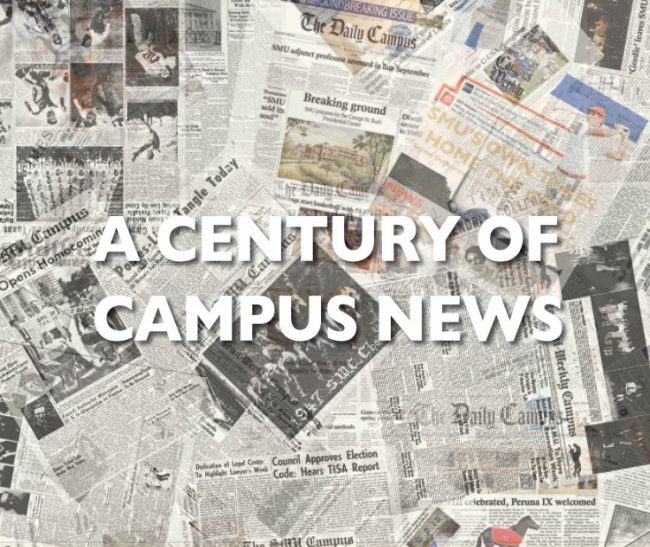Ed Fulton, member of the first SMU graduating Class of 1915, had much to look forward to at the start of the school year in September 1915.
He had just transferred to a new university and was being offered a new start. In fact, he was not just being offered a new start, he was being offered the opportunity to pave the way for the first graduating class of SMU, attending the opening of classes Sept. 24, 1915.
However, Fulton tackled another responsibility other than studying. He undertook the responsibility of publishing the first three editions of SMU’s student newspaper, which was first named the S.M.U. Times. Before the majority of students even moved onto campus, Fulton released the first edition Sept. 11, 1915 and passed the responsibility of editing to W. Harrison Baker in four editions.
Baker wrote in the fourth edition of the S.M.U. Times, “Our commission comes from the student body — it is their paper.”
Started by Fulton and Baker a century ago, the SMU Campus Weekly continues this mission of informing the student body. On Sept. 11, 2015, the publication celebrates its 100th year anniversary of its print edition.
As expected by any longstanding publication, the SMU Campus Weekly has gone through numerous changes and shifts in leadership. The name itself has changed numerous times to titles such as The Campus, The Semi-Weekly Campus, The SMU Campus and, most recently, The Daily Campus. Depending on the needs of the publication to fit stories and advertisements, the SMU Campus Weekly has also frequently increased and decreased the frequency of papers printed in a week.

In addition to printing changes to the paper, changing times define the direction of the paper. Len Faseler was the editor-in-chief of the newspaper from 1962-1963 in the midst of the Vietnam War.
“It was very much an agitated campus that year…some of the discussions inside the newsroom were more political. It was exciting for some of the people who were there,” Faseler said.
Technology over the past 100 years has changed the way the paper is produced. Before digital layout software, staff members printed the paper by cutting the stories and photos and pasting them onto the layouts.
“The final product was what was on the stands in the morning. It was exciting because you could never have a perfect paper and you always wanted to make a perfect paper for the next day,” said Dr. Beverly Martindale Horvit, editor-in-chief from 1988-1989.
The introduction of computers, however, revolutionized the newsroom. In 1989, SMU Student Media welcomed the first batch of Apple products into the newsroom.
“The things that we struggled with back then were photography….but now people can take them with their iPhones,” said Kristin Sullivan, editor-in-chief from 1989-1990.

Despite the transitions the newspaper has taken, the SMU Campus Weekly has maintained some defining characteristics throughout the century.
“It always has been and remains the independent voice of the students at SMU. There is no administrative or faculty control. Students have always been self-starters and motivated to produce campus news to the best of their ability,” said Carolyn Barta, professor of practice in the SMU Journalism School.
The SMU Campus Weekly also defines itself by tailoring its stories to its SMU audience.
“You aren’t reporting just on issues facing Dallas at large, even though Dallas comes into it, you focus on SMU,” said Jessica Huseman, editor-in-chief in 2010. “That level of attention allows you to hone your reporting in a way that isn’t possible in other publications.”
This constant attention to reaching its audience comes at a price.
“My first thought is how did everyone pass their classes. Because everyone was there all the time it felt like a full-time job,” Horvit said.
By teaching these work ethics, the SMU Campus Weekly prepares aspiring journalists.
“I got several internships at publications while I was in Dallas. I think The Daily Campus was more valuable because it was the only opportunity where students can get leadership in the newsroom and run the paper. Running the paper is inherently valuable,” Huseman said.
While the SMU Campus Weekly celebrates the success of a century of printed editions, some challenge the accomplishment by questioning the necessity of news in print due to the digitization of the news.
“I do think there is value in a print edition… But focus must be on a digital-first news product, because that’s the way people get their news today and that’s where jobs are going to be available for aspiring journalists,” Barta said.









